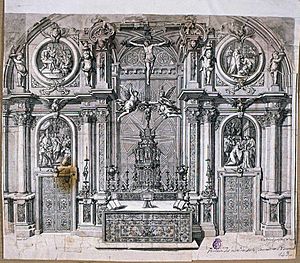Juan Bernabé Palomino facts for kids

Juan Bernabé Palomino y Fernández de la Vega (1692-1777) was a talented Spanish engraver. He was born in Córdoba and later lived and worked in Madrid.
Early Life and Training
Juan Bernabé Palomino came from an artistic family. His father was a silversmith, someone who works with silver. His uncle, Antonio Palomino, was a famous artist and writer. Juan learned a lot from his uncle. He worked in his uncle's studio in Madrid, helping to make prints from his uncle's drawings. He also helped with the printing plates for a book called El Museo pictórico y escala óptica.
After his uncle passed away in 1726, Juan went back to Córdoba. There, he spent time practicing and improving his engraving skills. He studied the works of other great artists to make his own technique perfect. Once he felt confident, he returned to Madrid.
Becoming a Master Engraver
Juan Bernabé Palomino became very well-known for his engraving work. In 1752, he was chosen to be the Director of Intaglio at the Real Academia de Bellas Artes de San Fernando. Intaglio is a special way of printmaking where the image is carved into a surface. He held this important position until he passed away. He was also given the special title of Court Engraver, meaning he worked for the royal family.
What Kind of Art Did He Make?
Juan Bernabé Palomino mostly created engravings. These were prints made from his carved plates. He made different types of art:
- Religious prints: Many of his works showed religious scenes or figures.
- Portraits: He made pictures of important people, like Isabel de Farnesio.
- Copies of famous artworks: He also made engravings that copied well-known paintings and sculptures by other artists. For example, he copied a sculpture of Saint Bruno by Manuel Pereira (sculptor). He also made prints of "Miracle of Saint Isidore" after Juan Carreño de Miranda and "Saint Peter in Prison" after Juan de Roelas.
- Book illustrations: Sometimes, he created pictures for books.
Juan Bernabé Palomino's son, Juan Fernando Palomino, also became a famous engraver. He followed in his father's footsteps and became an official at the Academia too.
See also
 In Spanish: Juan Bernabé Palomino para niños
In Spanish: Juan Bernabé Palomino para niños


